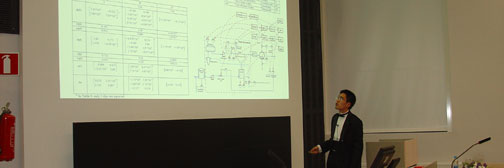Year 2016
Lauri P�riComparison of two interior point solvers in model predictive control optimization
Model Predictive Control (MPC) uses a mathematical programming problem to calculate optimal control moves through optimizing a cost function. In order to use MPC in a real industrial environment, the optimization solver needs to be efficient for keeping up with the time restrictions set by the control cycle of the process and robust for minimizing the inoperability of the controller in all situations.
In this thesis, a comparison of two interior point solvers in MPC optimization is conducted. The studied solvers are IPOPT optimization software package versions 1.6 and 3.12. The optimization software is tested using the NAPCON Controller which is an advanced predictive controller solution that utilizes the receding horizon model predictive control strategy.
The literature review of this thesis focuses on the basics of nonlinear optimization and presents the fundamentals of the Newton's method, Sequential Quadratic Programming (SQP) methods and Interior Point (IP) methods. State-of-the-art nonlinear programming software is reviewed and two commercially available nonlinear SQP solvers and two nonlinear IP solvers are presented. Additionally, the basics of model predictive control are covered.
The experimental section describes the used software and the implementation of the tests as well as the results. The solvers are tested using a hydrogen treatment process model that is simulated. The practical testing consists of cold start and warm start tests in which the time and number of iterations used for the optimization is tracked. The cold start tests constitute as the worst case scenario test in which the controller starts in a very unfavourable state which violates many constraints and the initial guess for the optimization problem is bad. The test is also run with different amounts of variables to also see how the problem size affects the optimization. In the warm start test, the NAPCON Controller is used to control the test process and a sequence of step changes. In addition, limit changes are executed to test how the solvers perform in real time MPC optimization. Warm start optimization utilizes the solutions from the previous iteration to solve the current optimization problem faster. The test is conducted to see how normal control actions and difficult circumstances affect the performance in continuous optimization.
The tests show that the IPOPT v. 3.12 outperforms the IPOPT v. 1.6 in each test by a large margin. The cold start tests show that the performance difference increases as the number of variables in the optimization problem increase and the growth in CPU time is approximately linear. The warm start tests show that the IPOPT v. 3.12 is also faster in continuous MPC optimization. When introducing disturbances IPOPT v. 3.12 solves the problem faster and returns to normal operation states more quickly than IPOPT v. 1.6.
Thesis electronical version can be downloaded from here
This info last modified 27 Apr 2024 by Jukka Kortela
| 
